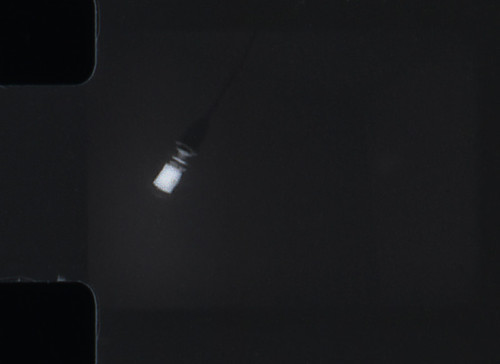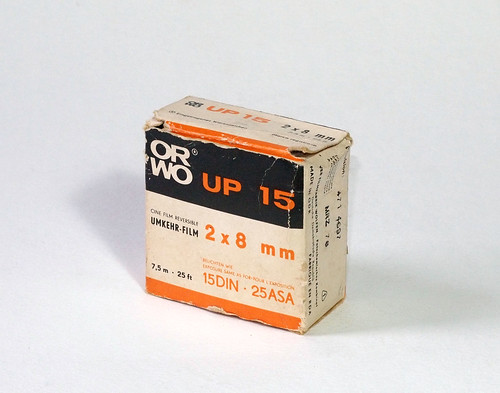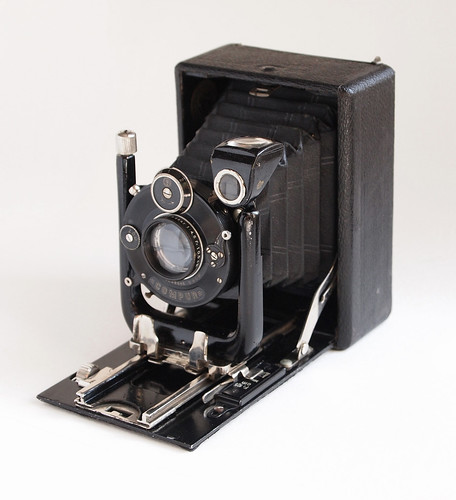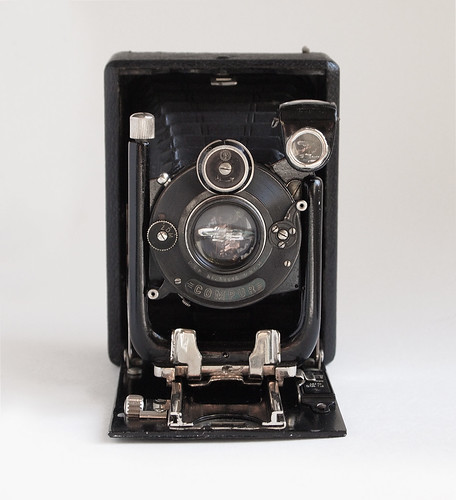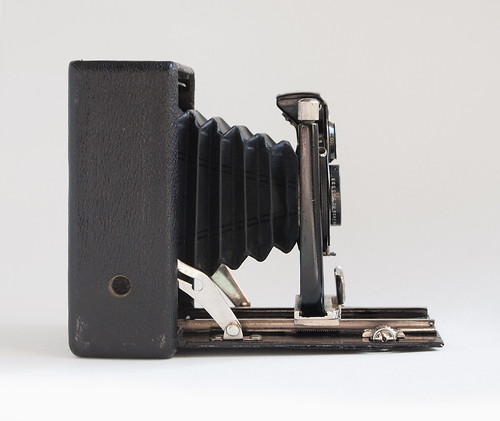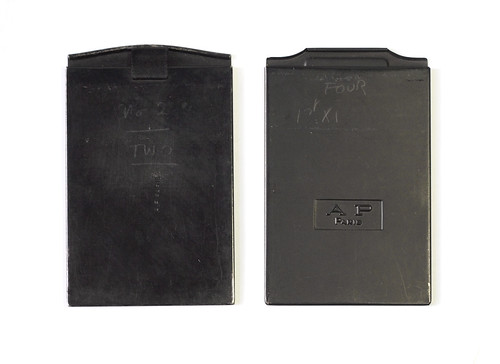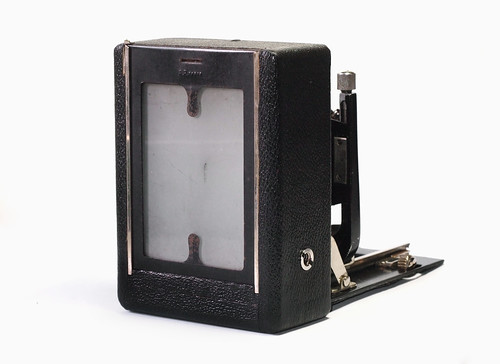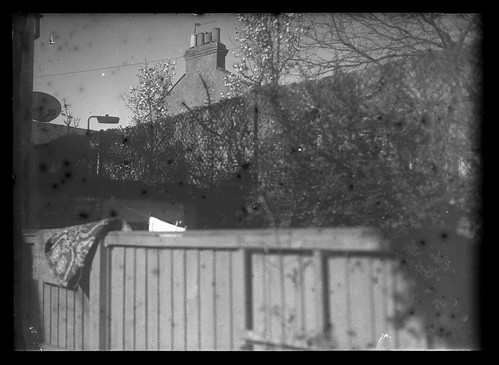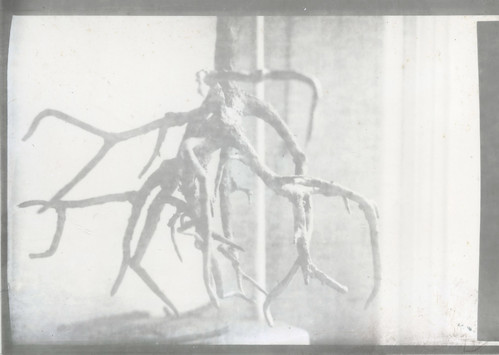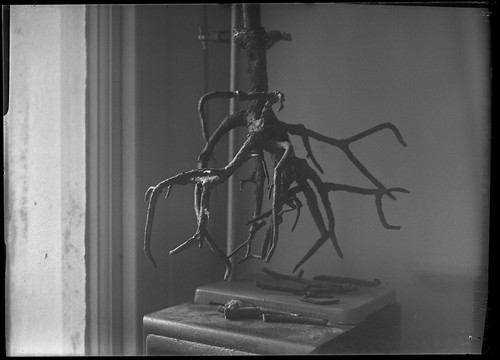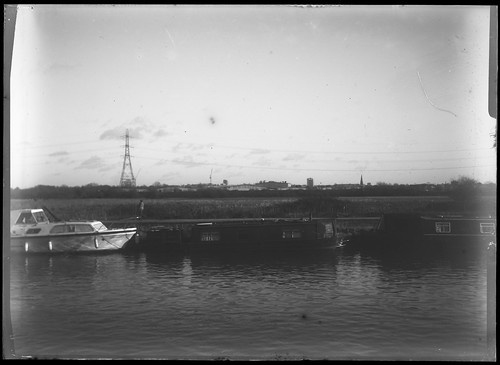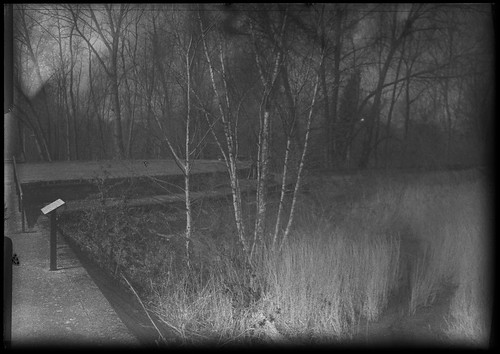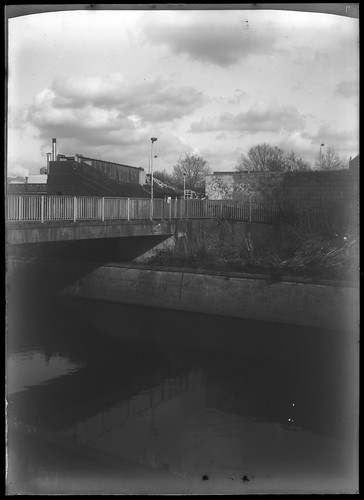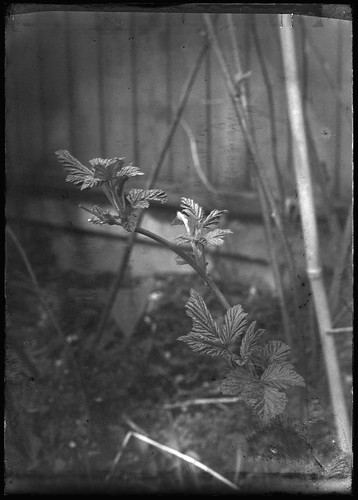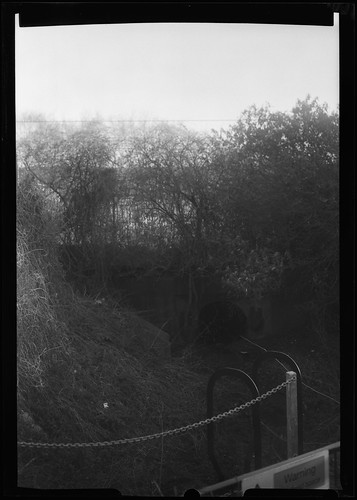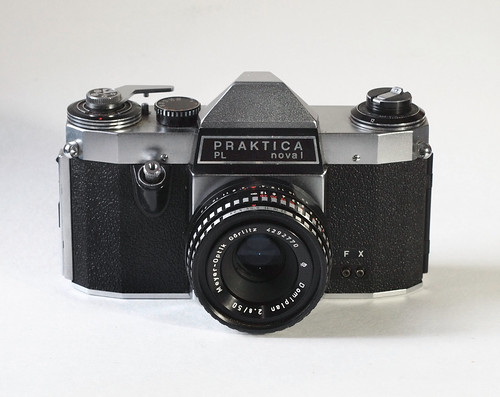 |
| Praktica nova I with 50mm f2.8 Domiplan lens |
On
Camera-Wiki and elsewhere, the camera that's the subject of this post is often referred to as the
Praktica PL Nova I. This is what's embossed on the camera's nameplate, reading from the top down and left to right; however, the name the manufacturer, Pentacon, uses, rather than that in more common usage, is simply
Praktica nova I. The
nova part, as well as on the nameplate, is also
written in the manual in lower case. The prominent
PL on the camera's nameplate stands for 'Pentacon load' or 'loading', one of a number of 'easy load' systems for 35mm cameras, such as Canon's Quick Load (QL) from around the same time, seen on the
Canon FTb-N, for example. These easy-load systems for 35mm cameras might be seen as a response, in part, to the introduction of Kodak's 126 cartridge in the early 1960s. There was an earlier
Praktica nova which differs most notably in its shutter speed dial, with the fast and slow speeds with separate selection on the same dial; the first Praktica nova was a complete redesign for the Praktica SLR, 'nova' intended to suggest this
newness. The Praktica nova cameras were produced after
KW, the Praktica's original manufacturer, was merged with the East German arm of Zeiss Ikon (and others) to form
VEB Pentacon. In the design of the Praktica nova I it's possible to see this merger in in the evolution of the Praktica nova body style: as well as deriving from previous Praktica cameras, it borrows elements - notably the shutter release design - from the
Zeiss Ikon Contax S (which itself derives from the Contax rangefinder before the war).
There are many references to the Praktica nova I online, which suggests that a large volume of cameras were produced - and that many are still being used today. On the
Praktica-Collector website, the production for the nova I is listed as 136,400 units, over five years from 1967. My model came in a job lot with a number of other cameras - including the
Vest Pocket Kodak and the
Kodak No.2A Brownie which I have previously written about. My first impressions of the Praktica nova I were of an unremarkable SLR camera - and the partly obscured focus screen (see below) did not enthuse me to pick up the camera to use it at the time I acquired it.
 |
| Praktica nova I with Domiplan lens |
As a student buying used cameras in the 1990s, Praktica were generally lowest in price, compared to those of Japanese manufacture (I don't recall seeing Zenit cameras very often at the time); Praktica cameras do seem to have had a not inconsiderable share of the UK market at the time, and as such are a familiar brand. My first SLR cameras were of the Praktica B-series of the 1980s, secondhand and a decade old when I first used them, something I touched on in my post
Twenty Years Since.
The Praktica nova I is much earlier than the B-series cameras I was using then. The camera is an entirely manual 35mm single lens reflex with a cloth focal plane shutter. There was a model B version of the camera, which has a selenium light meter incorporated into the name plate. The shutter release is on the front of the body, and angled, not on the
top, and is threaded for a cable release; this rotates to a lock
position, with a small red dot to indicate this. The shutter speeds run from 1 second through to 1/500th, plus 'B'. It also has a distinct setting for flash and the longer shutter speed numerals are picked out in red. For flash, there are
two PC sockets, marked F for flashbulbs and X for electronic flash. The manual states that the 1/30th shutter speed setting should be used with F, while X requires selecting the flash symbol setting: the manual states this to be 1/40th. There is no hot shoe (or accessory shoe) for flash, so using a flash requires an accessory mounting. On the advance lever, there's a film reminder with symbols for black and white and then four different types of colour film: daylight or tungsten in both transparency and negative. Around the rewind crank, where the exposure calculator on the nova I B model is located, is a reminder of the film speed, in ASA or DIN, to be matched up with the length of the film, 12, 20, or 36 exposures.
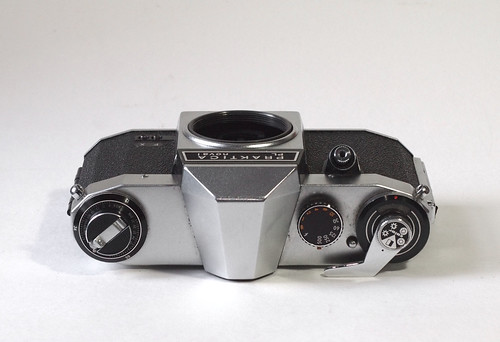 |
| Praktica nova I top view |
The camera back opens by a sliding latch on the side, rather than by pulling up the rewind crank. The PL system features two bars that clamp down on
the end of the film as the advance spool rotates with the advance lever. This seems
to work very well (on my limited use of the camera) in securing the end
of the film when loading. To rewind a film, rather than the more common
button on the underneath of the camera, there's a small knob by the
advance lever which pushes in to release the film for rewinding.
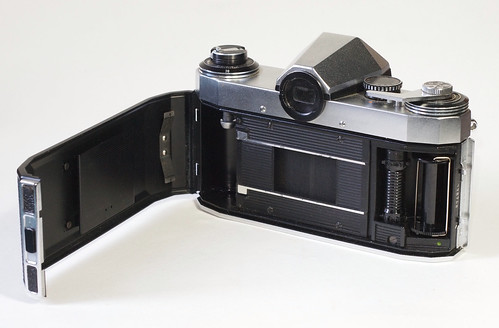 |
| Praktica nova I opened for loading |
There's a red 'flag' in the top left corner of the viewfinder to indicate that the film needs to be advanced. On my camera the focus screen had a white deposit over its surface in a number of places - appearing black against the light when seen through the viewfinder. It looked as though something had attacked the glass, etching it, possibly something in oil that had leaked out over the screen, but the patterns of this deposit appear inconsistent - some appearing to flow, some marks like cracks or stresses. This did not clean off with water; the focus screen could no doubt be changed, but it was still usable.
 |
| Praktica nova I focus screen with deposits |
The Praktica nova I has an
M42 screw lens mount. This allows for a very wide range
of compatible lenses, being a popular mount throughout the 1960s; the camera utilises the M42 automatic stopping-down pin; open at the widest aperture for composing and focussing, partially depressing the shutter release stops down the lens to the selected aperture. In the manual it also describes disengaging the automatic diaphragm, with a small lever inside the camera lens mount for
"older interchangeable lenses" - i.e., for lenses without an automatic stopping-down pin. The Praktica nova I came with a
Meyer-Optik Gorlitz 50mm f2.8 Domiplan lens; this was
the lower-priced standard lens for the camera on purchase.
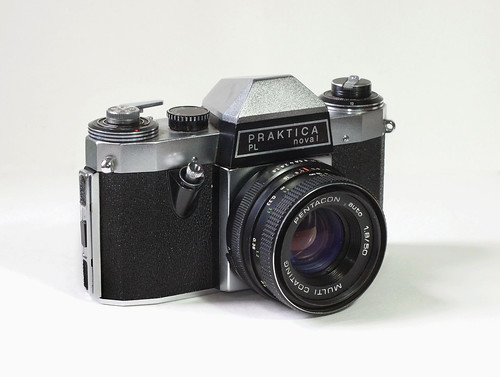 |
| Praktica nova I with 50mm f1.8 Pentacon lens |
For a comparison with the Domiplan lens which came with the camera, I also used a Pentacon f1.8 50mm lens on the Praktica nova I. As well as having a wider maximum aperture (giving a brighter image in the viewfinder), the Pentacon lens also has a much closer near-focus: it can focus down to 0.33m, whereas the Domiplan lens will focus to 0.75m, which does not feel especially close for a 'standard' 50mm lens on a 35mm SLR camera. The two images below show the difference with both lenses at their respective close-focus distance.
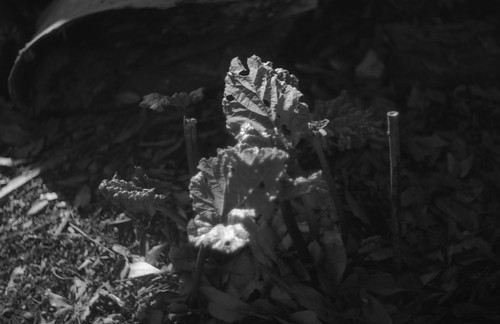 |
| Praktica nova I with Domiplan f2.8 50mm lens |
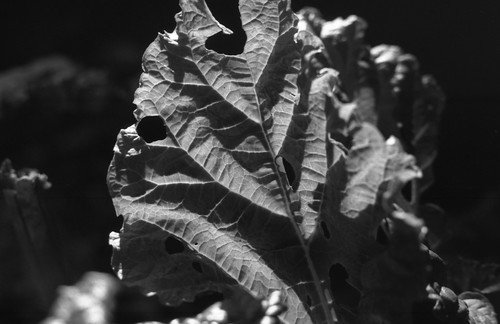 |
| Praktica nova I with Pentacon f1.8 50mm lens |
As well as the difference in close-focus distance, the Domiplan lens is clearly softer, with some flare evident, emphasised by the high contrast of the subject. The design of the Domiplan lens, with the aperture ring on its outside, rather than nearest to the body (an arrangement which seems more common), makes it easier to accidentally shift this ring while focussing.
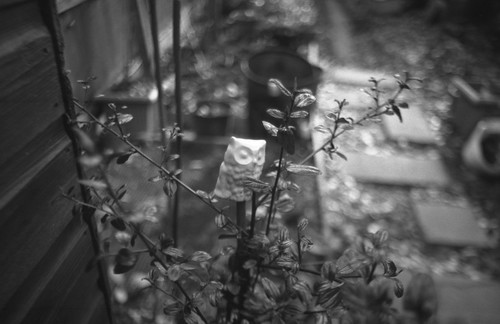 |
| Praktica nova I with Derek Gardner f2.8 28mm lens |
I took a few shots with a Derek Gardner 28mm lens (a rebranded Chinon lens); the lens' aperture blades closed very slowly on pressing the shutter button - slower than than one would normally take over taking a shot - and without realising, a number of shots with the Derek Gardner lens were over-exposed as a result. I also had a M42 2x Teleconverter picked up at a charity shop for £5, named
Helios Auto, no doubt to link it to the KMZ M42 Helios lenses, although the converter itself wasn't made by KMZ, for its origin, its marked simply 'Japan'. This worked well enough with the Pentacon lens stopped down.
The Praktica nova I is a basic, manual, mechanical 35mm SLR camera, and the lack of a lightmeter wouldn't necessarily make it a perfect choice for a camera in its class - there are many better 'entry-level' mechanical SLR cameras, such as the
Pentax K1000 for example. However, despite everything that could be placed against the Praktica nova I, in using the camera for a few rolls of film (and mostly using the 'sunny-16' rule for metering), I found the experience of it more positive than my first impressions. In use, the angled shutter release makes sense in terms of the position of one's fingers around the height of the camera's body, with the body design feeling quite ergonomically considered with its angled sides, and the stopping down on partially depressing the release fits naturally in the sequence of shooting; oddly, in using my camera, what feels
unergonimic is that the metal advance lever is thin and as a result feels a little flimsy. This would have originally had a plastic tip covering the end of the lever, as one might imagine it should - looking at a number of images online of the Praktica nova cameras, it seems that this loss is not uncommon.
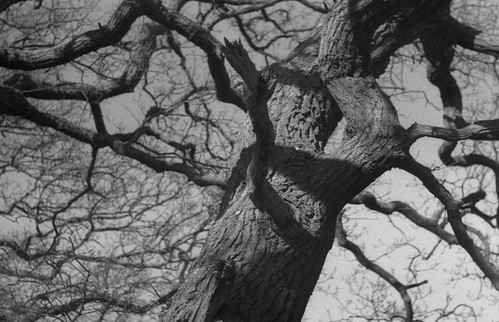 |
| Praktica nova I with Pentacon 50mm lens and Ilford Mark V film |
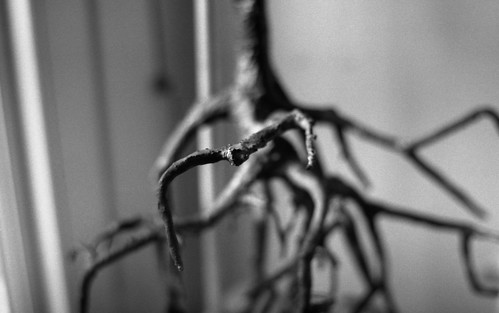 |
| Praktica nova I with Pentacon 50mm lens and Ilford Pan 100 |
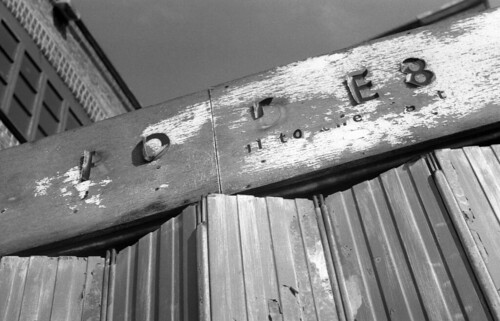 |
| Praktica nova I with Pentacon 50mm lens and Ilford HP5 Plus |
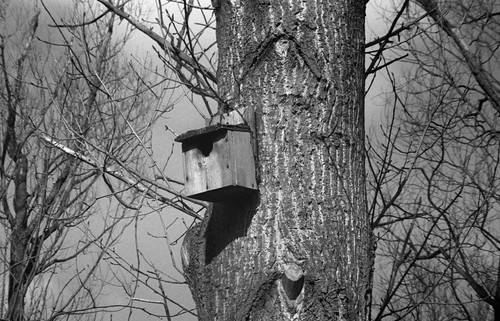 |
| Praktica nova I with Pentacon 50mm lens (2x teleconverter) and Ilford HP5 Plus |
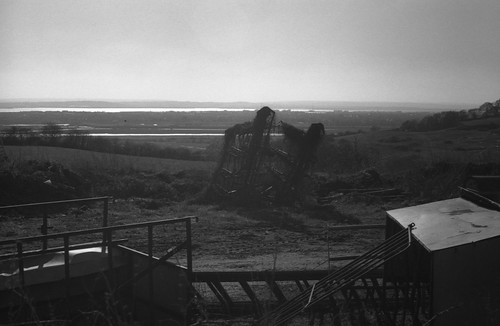 |
| Praktica nova I with Pentacon 50mm lens and Ilford XP2 Super |
Sources/further reading
Praktica nova I page on Camera-Wiki
Praktica nova I on praktica-collector.de
Praktica nova I (with pricing information) on Marriotworld
Evolution of the Praktica SLR on Dresdener-Kamera (German)
Filmphotography.eu - Praktica nova I (German)
Collection-Appareils Sylvain Halgand page on the Praktica nova I (French)
From the Focal Plane to Infinity - Praktica nova I (Spanish)














